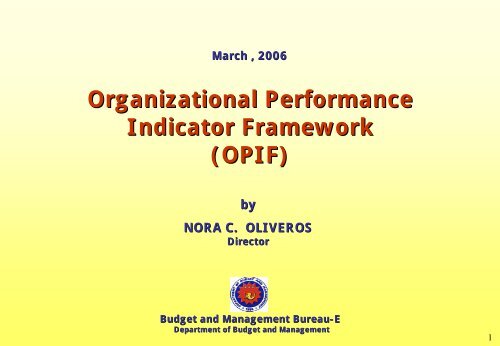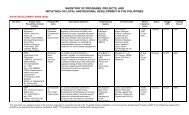Organizational Performance Indicator Framework (OPIF)
Organizational Performance Indicator Framework (OPIF)
Organizational Performance Indicator Framework (OPIF)
You also want an ePaper? Increase the reach of your titles
YUMPU automatically turns print PDFs into web optimized ePapers that Google loves.
March , 2006<br />
<strong>Organizational</strong> <strong>Performance</strong><br />
<strong>Indicator</strong> <strong>Framework</strong><br />
(<strong>OPIF</strong>)<br />
by<br />
NORA C. OLIVEROS<br />
Director<br />
Budget and Management Bureau-E Bureau E<br />
Department of Budget and Management<br />
1
PEM <strong>Framework</strong><br />
PEM<br />
MTEF <strong>OPIF</strong><br />
PEM – Public Expenditure Management<br />
MTEF – Medium Term Expenditure <strong>Framework</strong><br />
<strong>OPIF</strong> – <strong>Organizational</strong> <strong>Performance</strong> <strong>Indicator</strong> <strong>Framework</strong><br />
2
PEM Expected Results<br />
h Aggregate fiscal discipline - spending within<br />
affordable limits<br />
h Allocative efficiency - spending on the<br />
right things<br />
h Operational efficiency - providing goods<br />
and services at<br />
reasonable cost<br />
3
<strong>Organizational</strong> <strong>Performance</strong><br />
<strong>Indicator</strong> <strong>Framework</strong> (<strong>OPIF</strong>)<br />
An expenditure management<br />
approach designed to:<br />
� Direct resources towards results<br />
� Account for performance<br />
4
MFO<br />
(Outputs)<br />
<strong>OPIF</strong> Key Elements*<br />
<strong>OPIF</strong><br />
* Strategic Allocation of Resources per Major Final Outputs (MFO)<br />
<strong>Performance</strong> <strong>Indicator</strong>s<br />
(Output/Outcome - based)<br />
* <strong>Performance</strong> Measurement System per output-outcome-based performance indicators<br />
5
ANALYTICAL FRAMEWORK<br />
Logical <strong>Framework</strong> (Logframe) Approach in <strong>OPIF</strong><br />
Establishing Linkages between:<br />
(Impact)<br />
(Outcome)<br />
(Outputs)<br />
(Inputs)<br />
SOCIETAL GOALS<br />
SECTOR GOALS<br />
ORGANIZATIONAL OUTCOME<br />
MAJOR FINAL OUTPUTS<br />
P/A/Ps<br />
BUDGET<br />
<strong>Performance</strong><br />
<strong>Indicator</strong>/s<br />
Targets<br />
6
<strong>Organizational</strong> Outcomes: Examples<br />
• Department of Public Works and Highways:<br />
– “Improved national network for access and mobility of<br />
people, goods and services”<br />
• Department of Labour and Employment:<br />
�“Jobs/ income for assisted individuals”<br />
7
Major Final Outputs (MFOs)<br />
• Goods and services that a department or agency is<br />
mandated to deliver to external clients<br />
�Directly contributing to organizational outcomes<br />
�Through the implementation of programs, activities, and<br />
projects (PAPs)<br />
• Consumed outside of the organization<br />
• Tangible and more easily quantified<br />
• Within the control of the department/ agency<br />
8
MFOs: Examples<br />
• DSWD MFOs:<br />
� Policies, plans and programs formulated for social welfare and development<br />
concerns<br />
� Licences and accreditation issued to intermediaries; implemented and<br />
enforced<br />
� Training and capability services to intermediaries<br />
� Social welfare services delivered to center-based clients<br />
• DPWH MFOs<br />
� Properly maintained national roads<br />
� Well-constructed/ improved/ rehabilitated national roads<br />
� Properly maintained major flood control structures/ facilities<br />
� Well-constructed / improved/ rehabilitated major flood control structures/<br />
facilities<br />
� Quality engineering and other specialized support services<br />
9
Programs/Activities/Projects<br />
(P/A/Ps)<br />
• Key policy, activities or integrated group<br />
of activities (programs) and projects<br />
undertaken by the department/agency to<br />
achieve MFOs<br />
10
PAPs: Examples<br />
• DOH PAPs for Health Regulation MFO:<br />
�Regulation of Food & Drugs including National<br />
Pharmaceutical Policy, Food Fortification & Salt<br />
Iodization<br />
�Regulation of Health Facilities & Services<br />
�Regulation of Health Devices & Technology<br />
�Quarantine Services & International Surveillance<br />
11
Where we are:<br />
1. Logical framework for 13 pilot departments and 2 agencies:<br />
Department : (OSEC level): DPWH, DOE, DOH, DOT, DSWD DOLE,<br />
DFA, DOJ, DILG, DBM<br />
: (whole department): DA, DAR, DENR<br />
Agencies : PNP, NAPOLCOM<br />
2. Finalizing <strong>OPIF</strong> documents for pilot department/agencies, for<br />
submission to Congress<br />
3. Thru PEGR facility, BMBs ”on the job” capacity building in full<br />
swing for logical framework of remaining 7 departments*<br />
4. 2 nd wave of logical framework development for pilot<br />
departments to be undertaken (logframe for the whole<br />
department, i.e., including attached agencies)<br />
5. Targeting an <strong>OPIF</strong>-based 2007 budget for 20 departments<br />
and all departments and agencies by 2008<br />
* DTI, DOTC, DepEd; NEDA; DOF; DOST; DND<br />
12
Implications/Requirements<br />
1. MFO-budget structure alignment<br />
– PAP-MFO linking<br />
– “Serious” agency preparation & DBM evaluation of MFO<br />
Budget Matrices A & B<br />
– Minor adjustments in BPMS (or addition of <strong>OPIF</strong>-based<br />
budget module)<br />
2. Refinements / Enhancements of:<br />
– MFO <strong>Performance</strong> indicators<br />
– MFO targets & cost requirement<br />
3. MFO-APR alignment<br />
– Designing an <strong>OPIF</strong>-based APR<br />
13
Implications/Requirements<br />
4. Institutionalization of <strong>OPIF</strong><br />
– Mainstreaming <strong>OPIF</strong> APR in budget preparation and<br />
execution/review systems<br />
– <strong>OPIF</strong>-perspective in inspectorate<br />
– Continued and consistent advocacy to:<br />
• Agencies<br />
• Congress<br />
• Other stakeholders<br />
– Integration in budget processes, policies & management<br />
decisions<br />
– Making other reforms <strong>OPIF</strong>-based<br />
• Rationalization (EO 366)<br />
• MTEF/FE<br />
14
Where to from here?<br />
Results- Based Budgeting<br />
and <strong>Performance</strong><br />
Management<br />
15
Ongoing PEM Reforms<br />
• Forward Estimates<br />
� Rolling three-year expenditure estimates<br />
� Expected financial implications of the budget-year<br />
policy decisions<br />
� Help achieve funding predictability for outputbased<br />
budgeting<br />
• Budget Strategy Paper<br />
� Outlines government’s strategic directions on<br />
fiscal policy, developmental priorities and resource<br />
allocation<br />
16
<strong>OPIF</strong> and Ongoing PEM and other Reforms<br />
• Linking <strong>OPIF</strong> and the Current Reforms in the Budget<br />
Process:<br />
� Integration with FEs and Budget Strategy Paper to<br />
provide greater funding and policy certainty<br />
� Improve allocative decisions following costings of<br />
MFOs<br />
� Greater transparency-Financial and Management<br />
Information System capable of processing<br />
performance information<br />
� Greater accountability through annual performance<br />
reporting<br />
� Tighter external audits, including performance<br />
audits<br />
17
Transforming <strong>Performance</strong> measurement<br />
to <strong>Performance</strong> Management<br />
• Process of transformation<br />
� Undertake Department planning and address<br />
human resource issues<br />
� Develop Business Group Strategies and<br />
Operational Plans<br />
� Introduce individual performance agreements and<br />
personal development<br />
� Implement performance reviews<br />
• Capacity building, leadership and management culture<br />
� Leadership and change management<br />
� Teamwork<br />
� Delegation, trust and empowerment<br />
� Learning organization<br />
18
Why <strong>OPIF</strong> Matters: the Government<br />
and Community<br />
• Increased effectiveness for core business<br />
� Integrate agencies’ strategic and financial planning<br />
� Links operations and strategies<br />
� Links planning and budgeting processes<br />
• Improved efficiency in policy implementation and<br />
service delivery<br />
� Managers focus on results - the how, what and why<br />
� Improved reporting and enhance transparency<br />
• Better resource allocation<br />
� Improve the quality of budgetary decision-making<br />
19
Why <strong>OPIF</strong> Matters: Departments & Agencies<br />
• Clarifies roles, functions, and accountabilities<br />
among agencies<br />
• Predictable funding for core business<br />
�Predicated on a reformed Plan-Budget process,<br />
better cash management, Contingency Reserve<br />
�Greater control over internal resource deployment<br />
• Manage performance expectations<br />
�What is achievable and realistic within funding<br />
constraints<br />
• Communication tool<br />
• Better workforce<br />
�Encourage innovation<br />
� More job satisfaction<br />
20
Why <strong>OPIF</strong> Matters: Employees<br />
• Clarity of objectives<br />
� Through the business planning and performance<br />
management process, employees can see how their<br />
activities contribute to organizational outcomes<br />
• Better job satisfaction<br />
� Better task delegation, clear links to corporate goals<br />
• <strong>Performance</strong> Incentives<br />
� potential to provide rewards for performance<br />
• Career Development<br />
� Better communications between managers and<br />
staff, regular and effective performance feedback,<br />
personal development an integral part of<br />
performance management<br />
21
Final Thoughts<br />
• Results based budgeting and <strong>Performance</strong><br />
Management is a long-term agenda, not a<br />
short-term measure<br />
• Leadership is a precondition for effective<br />
reform<br />
• Reform must be a continuous process, not<br />
a one-time fix<br />
• This is a reform process that requires<br />
commitment by all<br />
22
PROPOSED LOGFRAME FOR <strong>OPIF</strong><br />
DEPARTMENT OF BUDGET AND MANAGEMENT<br />
Societal Goal<br />
Sectoral Goals<br />
<strong>Organizational</strong><br />
Outcomes<br />
Major Final<br />
Outcomes<br />
Poverty Alleviation<br />
Fiscal Strength Anti-Corruption Bureaucratic Reforms<br />
A. Improved Operational<br />
Efficiency of NGAs<br />
1. Staffing Compensation<br />
& <strong>Organizational</strong><br />
Standards, Guidelines,<br />
Procedures, Systems<br />
Developed, Plans &<br />
Proposals Reviewed &<br />
Approved and<br />
Compliance Monitored<br />
B. Improved Allocative<br />
Efficiency<br />
1, 4, 5, 2, 4,<br />
2. Expenditure<br />
Policies &<br />
Guidelines<br />
Formulated,<br />
Disseminated &<br />
Monitored<br />
C. Strengthened Fiscal<br />
Responsibility and<br />
Discipline<br />
2, 3, 4,<br />
3. Fiscal Budget<br />
Programs<br />
Submitted to<br />
President/<br />
Congress<br />
4. Budget<br />
Authority &<br />
Cash<br />
Requirements<br />
Released to<br />
NGAs, GOCCs<br />
& LGUs and<br />
Monitored<br />
(ARP)<br />
D. Enhanced<br />
Accountability and<br />
Increased Transparency<br />
in Public Sector<br />
4, 5,<br />
5. Technical<br />
Assistance<br />
Rendered to<br />
NGAs, GOCCs,<br />
LGUs in Budget<br />
& Management,<br />
Procurement<br />
Reform<br />
24
Draft <strong>Performance</strong> <strong>Indicator</strong>s<br />
MFO 1: Staffing, Compensation and <strong>Organizational</strong> Standards, Guidelines,<br />
Procedures, Systems Developed, Plans & Proposals Reviewed & Approved<br />
and Compliance Monitored<br />
a. Number of policies, standards, procedures, guidelines, systems<br />
developed<br />
b. Deviations from prescribed processing time<br />
c. Number of major & minor plans & proposals reviewed &<br />
approved/denied<br />
MFO 2: Expenditure Policies and Guidelines Formulated, Disseminated &<br />
Monitored Refinements / Enhancements of:<br />
a. Number & types (Fiscal & Operational) of policies & guidelines<br />
formulated<br />
b. Deviations from set deadlines<br />
c. % of 1 st time acceptance by “clients” (DBCC)<br />
MFO 3: Fiscal & Budget Programs Submitted to President/Congress<br />
a. Deviation from legal deadline<br />
b. Deviation of budget submitted from levels set by DBCC<br />
25
Draft <strong>Performance</strong> <strong>Indicator</strong>s<br />
MFO 4: Budget Authority & Cash Requirements Released to NGAs, GOCCs, &<br />
LGUs and Monitored (APR)<br />
a. Percentage of adherence of actual releases with budget program<br />
approved by DBCC in terms of allotment and cash allocation<br />
b. Deviation from set time standards for budget releases<br />
c. Deviation from set time standards for COBs & LGUs budget review<br />
d. Percentage of reviews (COBs & LGUs) completed by set deadlines<br />
(from date submitted?)<br />
MFO 5: Technical Assistance to NGAs, GOCCs, LGUs in Budget & Management,<br />
Procurement Reform<br />
a. Number of organizations & type assisted<br />
b. Number of persons (male, female) given technical assistance<br />
c. Person-days of training & subject areas<br />
d. Level of beneficiary satisfaction person days of technical assistance &<br />
subject areas<br />
e. Level of skills/knowledge (5 th P.D. – Advanced, 2-4P.D. –<br />
Intermediate, 1 st P.D. – Basic) given in trainings<br />
26




